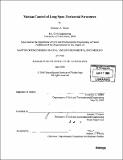Motion control of long span horizontal structures
Author(s)
Shultz, Nicholas A. (Nicholas Andrew)
DownloadFull printable version (11.16Mb)
Other Contributors
Massachusetts Institute of Technology. Dept. of Civil and Environmental Engineering.
Advisor
Jerome J. Connor.
Terms of use
Metadata
Show full item recordAbstract
Traditional approaches to structural design presuppose strength to be the dominant design requirement. But following new technologies and design methods, this assumption that strength requirements dominate is being challenged. In the design of horizontal structures, such as floor systems and pedestrian bridges, increasing lengths of column-free span and demands for material efficiency have led to an overall reduction in the structural properties of mass, stiffness and damping. These three properties traditionally controlled motion-related serviceability issues, but this is no longer the case. Engineers are increasingly reporting vibration problems in horizontal structures. Hence, the dominant design criterion has shifted from a basis of strength to one of motion. This thesis attempts to investigate the code requirements and state of the art analysis techniques involved in the vibration control of horizontal structures. Design techniques involving passive control, active control and some alternative control methods are discussed and evaluated, both qualitatively and quantitatively, through a series of example problems. (cont.) Conventional engineering knowledge addresses vibration problems by increasing stiffness; however, this study indicates that these problems may be resolved much more efficiently by increasing damping, perhaps through the use of a tuned mass damper. Recommendations are made, suggesting that structural engineers should give serious consideration to the dominance of serviceability issues in design. As vibration problems continue to become more prevalent with ever-increasing span lengths, the time will come when non-traditional solutions, such as the use of tuned mass dampers to control vibrations, can no longer be ignored.
Description
Thesis (M. Eng.)--Massachusetts Institute of Technology, Dept. of Civil and Environmental Engineering, 2006. Includes bibliographical references (leaves 55-57).
Date issued
2006Department
Massachusetts Institute of Technology. Department of Civil and Environmental EngineeringPublisher
Massachusetts Institute of Technology
Keywords
Civil and Environmental Engineering.